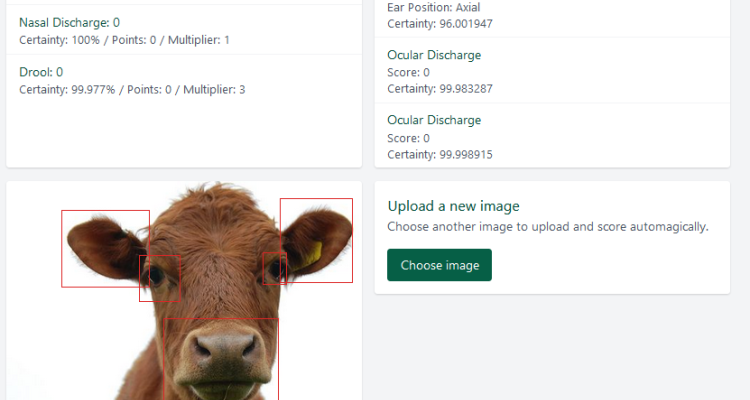
Use case
Detecting disease with computer vision
Wageningen researcher Ronald Petie used computer vision to detect diseases in cows as part of two projects: SensingPotential and Digitool. It turns out that, like in humans, a runny nose is a sign of possible illness in cows too. “The more photographs of cow heads we feed into the algorithm, the better it learns to recognise the data and the more accurate its predictions.”
How did you come up with the SensingPotential and Digitool projects and what do they involve?
“I work at Wageningen Bioveterinary Research (WBVR), where, among other things, we conduct research into infectious animal diseases such as foot-and-mouth-disease. We wanted to make use of non-invasive sensors, i.e. sensors that do not need to be inserted into the animal, to monitor the animals at our facility in Lelystad. That gave us the idea to photograph cow heads to see what information we could derive from them. The result is a facial recognition system that assigns a disease score to an animal based on facial signs. The system was tested during an experiment with foot-and-mouth disease at our facility, and the scores the system gave corresponded remarkably well with the actual course of the disease during the trial.”
So what signs do you see in a sick cow? Watery eyes and a runny nose?
Ronald laughs: “You’re spot on! Nasal and ocular discharges are actually two of the elements we monitor. We also monitor salivation, the position of the ears, the presence of wounds, and the position of the eyes and the cornea.”
The position of the ears can be an indication of the cow’s emotional state. Surprisingly, it matters whether it is the left or the right ear.
What can you conclude from these facial signs?
“The eyes in sick animals are set deeper, while a cloudy cornea may indicate infection. The position of the ears can be an indication of the cow’s emotional state. What surprised me is that it matters whether it is the left or the right ear. Normally, the ears of a cow are horizontal, but in stress, the left ear will point backwards, while if the right ear hangs down slightly it is a sign of well-being. If both ears are pointed up, the animal is alert. These different positions are connected to the left and right brain hemispheres.”
Why is it important to detect diseases?
“Modern intensive farmers keep more and more animals. The more animals per farm, the less time the farmer can spend on each animal. If a farmer is alerted sooner that an animal is unwell, they can be isolated earlier and so prevent the disease from spreading. The chance of diseases spreading is also increased by this intensification: more animals means more contact and more opportunities for diseases to be transmitted.”
What opportunities do you see for this technology?
“It will initially be used by organisations that carry out animal experiments at Wageningen Bioveterinary Research, such as pharmaceutical companies. We are still in the purely scientific phase and are looking for opportunities to apply the technology. If it comes up to our expectations, I can see dairy farms and veal farms benefitting from it. On veal farms, the animals are sourced from various locations, which brings an additional risk of disease transmission. If you can screen and separate sick animals on arrival, it will make a big difference. It means farmers can use less antibiotics, because they will only have to treat those animals in which a disease has been detected, instead of preventively treating the whole barn.”
What prompted you to do this research?
Sensors for detecting diseases have become feasible thanks to the huge amount of data that is now available. We developed the project with the help of two universities of applied sciences, HAS and AVANS, both in Den Bosch. The students developed the scoring system for us. To do this, they had to delve deep into the literature to learn which clinical symptoms were significant and what they meant. They manually annotated photos taken at our animal facilities with the information about these symptoms. Students of the Data Science minor subsequently automated the process.”
Computer vision will enable farmers to use less antibiotics, because they will only need to treat those animals in which a disease has been detected, and not the whole barn.
Which technologies are used in the projects?
“Machine learning and deep learning. The more photographs of cow heads we feed into the algorithm, the better it learns to recognise the data and the more accurate its predictions. We have since uploaded 700 photos. That is not a huge amount, but we used and retrained an existing deep learning model that already contained millions of photographs, so we did not need to add a lot of new material to get the first results. Deep learning involves training a neural network that learns from data. So we will need to feed it a lot more photographs yet.”
Will the projects be continued?
“Yes, we are going to do a follow-up project with HAS, but now in pigs. In addition to faces, we will also include the animals’ postures. We have a lot of video material from our own facilities in Lelystad that we can put to good use.”
Do you have a question about this topic?
Ask our expert: